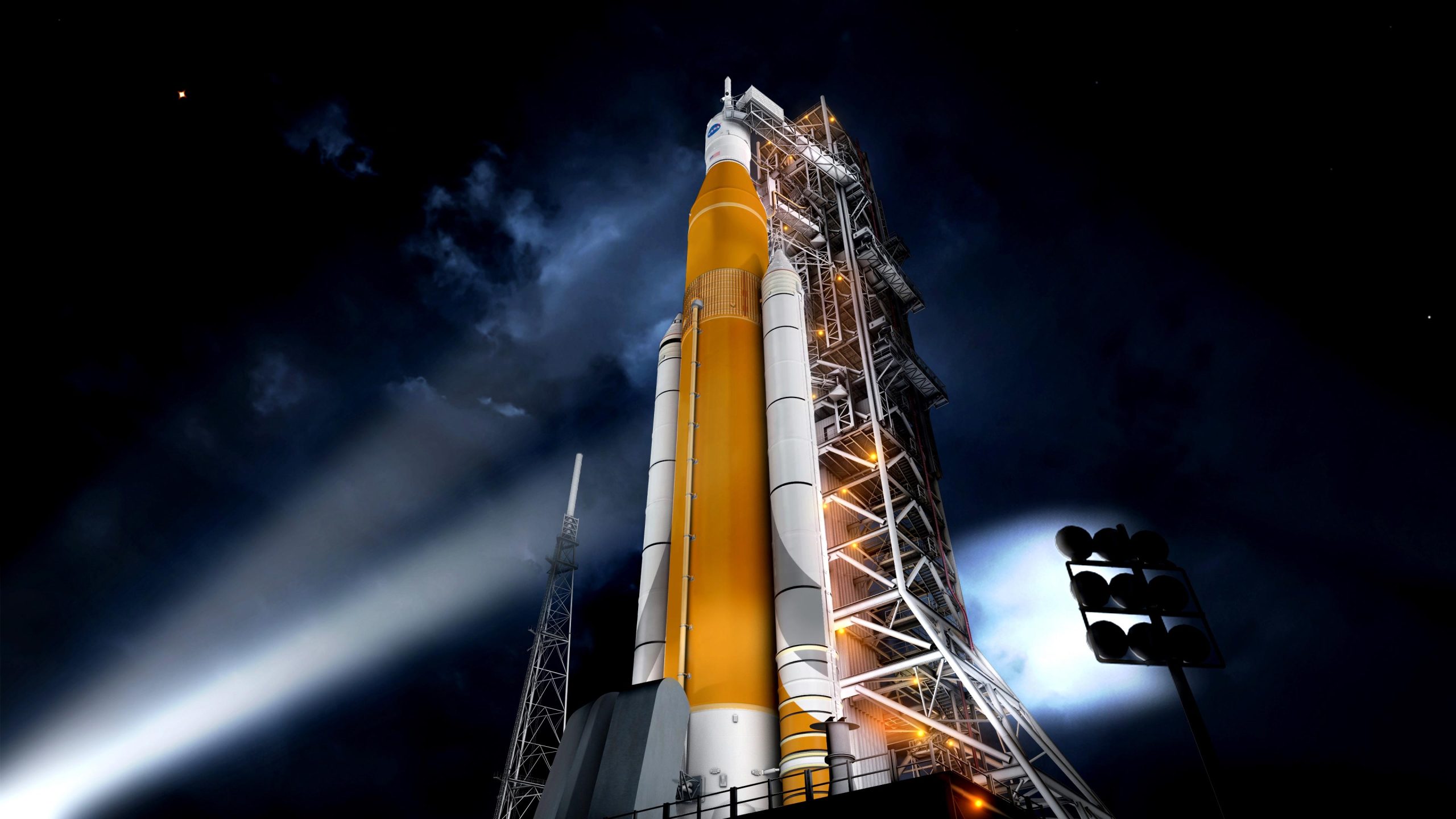Ilustrasi roket Space Launch System dan pesawat ruang angkasa Orion di landasan peluncuran. Kredit foto: NASA
Eksekutif NASA memberi lampu hijau untuk peluncuran Artemis I, hitungan mundur aktif
Manajer Artemis I bertemu pada Senin sore untuk meninjau status operasi hitung mundur ditambah dua buka objek teknisdan memberikan lampu hijau untuk peluncuran pada Rabu, 16 November. Jendela peluncuran dua jam terbuka pada 1:04 EST.
Para insinyur melakukan analisis detail sealant pada sambungan antara ogive sistem pembatalan peluncuran Orion dan adaptor modul kru, dan menganalisis potensi risiko jika terlepas saat peluncuran. Tim manajemen misi menentukan bahwa kemungkinan kecil bahwa merobek material tambahan akan menimbulkan risiko kritis terhadap penerbangan.
Ringkasan singkat dari[{” attribute=””>NASA’s history in space exploration segueing to Artemis serves as the opening video for the launch broadcast for the agency’s Artemis I mission. The broadcast originates from Kennedy Space Center in Florida, where NASA’s Space Launch System rocket and Orion spacecraft will lift off from Launch Complex 39B no earlier than November 16 on a mission beyond the Moon and back to Earth. Credit: NASA
Technicians also completed replacing a component of an electrical connector on the hydrogen tail service mast umbilical. While swapping the component did not fully fix the issue, engineers have redundant sources of information supplied through the connector.
Listen to a replay of the Artemis I Prelaunch Mission Update media teleconference that took place on November 14.

The area where caulk on a seam between the Orion launch abort system’s ogive and crew module adapter detached during Hurricane Nicole. Credit: NASA
The countdown, which began Monday at 1:54 a.m., is progressing smoothly. All elements of the rocket and spacecraft are powered up. Overnight, teams will charge flight batteries, conduct final walkdowns at the launch pad, and check out communications with Orion.
Weather conditions remain 90% favorable for the Artemis I launch based on the Monday, November 14 forecast from meteorologists with the U.S. Space Force Space Launch Delta 45.

A close-up view of the area.where caulk on a seam between the Orion launch abort system’s ogive and crew module adapter detached during Hurricane Nicole. Credit: NASA
The following milestones remaining in the countdown are below. Live coverage of tanking operations with commentary on NASA TV will begin on Tuesday, November 15 at 3:30 p.m. Full launch coverage in English will begin at 10:30 p.m. Click here for the latest information on launch briefings and events.
L-32 hours and counting
- Core stage composite overwrapped pressure vessel (COPV) Pressurization to Flight Pressure (L-32M – L-23H)
- The ICPS is powered down (L-31H – L-30H30M)
- Charge Orion flight batteries to 100% (L-31H – L-27H)
- Charge core stage flight batteries (L-28H – L-22H)
- The ICPS is powered-up for launch (L-19H30M – L-16H30M)
L-15 hours and counting
- All non-essential personnel leave Launch Complex 39B (L-13H – L-11H)
- Ground Launch Sequencer (GLS) activation (L-11H15M – 10H15M)
- Air-to-gaseous nitrogen (GN2) changeover and vehicle cavity inerting (L-11H45M – launch)
L-10 hours, 40 minutes and counting
- 3.5-hour built in countdown hold begins (L-10H40M – L-7H10M)
- Launch team conducts a weather and tanking briefing (L-10H40M – L-9H50M)
- Launch team decides if they are “go” or “no-go” to begin tanking the rocket (L-9H40M)
- Core stage LOX transfer line chilldown (L-9H15M – L-9H)
- Core stage LH2 transfer line chilldown (L-9H15M – L-8H45M)
L-8 hours and counting
- Core stage LOX main propulsion system chilldown (L-9H – L-8H20M)
- Core stage LH2 slow fill start (L-8H45M – L-7H50M)
- Core stage LOX slow fill (L-8H20M – L-8H5M)
- Core stage LOX fast fill (L-8H5M – L-5H15M)
- Core stage LH2 fast fill (L-7H50M – L-6H10M)
- Engine bleed kick start (L-7H40M – L-7H20M)
- Core stage LH2 topping (L-6H10M – L6H5M)
- Core stage LH2 replenish (L-6H5M – launch)
- Core stage LOX topping (L-5H15M– L-5H5M)
- ICPS LH2 ground support equipment and tank chilldown (L-5H20M – L-5H)
L-5 hours and counting
- Core stage LOX replenish (L-5H5M – launch)
- ICPS LOX main propulsion system chilldown (L-5H5M– L-4H45M)
- ICPS LH2 fast fill start (L-5H5M – L4H5M)
- Orion communications system activated (RF to mission control) (L-4H20M – L-3H45M)
- ICPS LOX fast fill (L-4H55M– L-4H10M)
- ICPS LOX validation and leak test (L-4H10M – L-3H40M)
- ICPS LH2 validation and leak test (L-4H – L-3H40M)
- ICPS LH2 tank topping start (L-3H40M – L-3H25M)
- ICPS LH2 replenish (L-3H25M – launch)
- ICPS LOX topping (L-3H40M – L-3H20M)
- ICPS LOX replenish (L-3H20M – launch)
- ICPS/Space Launch System telemetry data verified with Mission Control Center and SLS Engineering Support Center (L-2H55M – L-2H45M)
- ICPS LOX validation and leak test (L-2H55M – L-2H30M)
- ICPS LH2 replenish (L-2H50M – launch)
- ICPS LOX topping (L-2H30M – L-2H10M)
- ICPS LOX replenish (L-2H10M – launch)
- ICPS/Space Launch System (SLS) telemetry data verified with Mission Control Center and SLS Engineering Support Center (L-3H – L-2H50M)
L-50 minutes and counting
- Final NASA Test Director briefing is held (L-50M)
L-40 minutes and holding
- Built in 30-minute countdown hold begins (L-40M)
L-15 minutes and holding
- The launch director polls the team to ensure they are “go” for launch
T-10 minutes and counting
- Ground Launch Sequencer (GLS) initiates terminal count (T-10M)
- GLS go for core stage tank pressurization (T-6M)
- Orion ascent pyros are armed (T-6M)
- Orion set to internal power (T-6M)
- Core stage LH2 terminate replenish (T-5M57S)
- GLS is go for flight termination system (FTS) arm (T-5M)
- GLS is go for LH2 high flow bleed check (T-4M40S)
- GLS is go for core stage auxiliary power unit (APU) start (T-4M)
- Core Stage APU starts (T-4M)
- Core stage LOX terminate replenish (T-4M)
- ICPS LOX terminate replenish (T-3M30S)
- GLS is go for purge sequence 4 (T-3M10S)
- ICPS switches to internal battery power (T-1M56S)
- Core stage switches to internal power (T-1M30S)
- ICPS enters terminal countdown mode (T-1M20S)
- ICPS LH2 terminate replenish (T-50S)
- GLS sends “go for automated launch sequencer” command (T-33S)
- Core stage flight computer to automated launching sequencer (T-30S)
- Hydrogen burn off igniters initiated (T-12S)
- GLS sends the command for core stage engine start (T-10S)
- RS-25 engines startup (T-6.36S)
T-0
- Booster ignition, umbilical separation, and liftoff

Artemis I will be the first integrated flight test of NASA’s deep space exploration system: the Orion spacecraft, Space Launch System (SLS) rocket and the ground systems at Kennedy Space Center in Cape Canaveral, Florida. The first in a series of increasingly complex missions, Artemis I will be an uncrewed flight that will provide a foundation for human deep space exploration, and demonstrate our commitment and capability to extend human existence to the Moon and beyond. Credit: NASA
Selama penerbangan ini, pesawat ruang angkasa Orion akan meluncurkan roket paling kuat di dunia dan terbang lebih jauh daripada pesawat ruang angkasa buatan manusia yang pernah diterbangkan. Ini akan melakukan perjalanan 280.000 mil dari Bumi, ribuan mil di luar Bulan, selama misi sekitar tiga minggu. Orion akan tinggal di luar angkasa lebih lama daripada pesawat ruang angkasa astronot mana pun tanpa berlabuh dengan stasiun luar angkasa, dan kembali ke rumah lebih cepat dan lebih panas dari sebelumnya. Kredit foto: NASA

“Ninja twitter bersertifikat. Ahli internet. Penggemar budaya pop hardcore. Baconaholic.”
You may also like
-
Aturan matematika ditemukan di balik distribusi neuron di otak kita
-
Para ilmuwan menemukan penjelasan untuk lubang gravitasi raksasa di Samudra Hindia
-
Peta baru yang akurat dari semua materi di alam semesta dirilis
-
Para ilmuwan mengatakan sepasang bintang yang sangat langka berperilaku sangat ‘aneh’
-
Lima Angsa Tewas Setelah Terbang Ke Saluran Listrik Hinkley | Berita Inggris

